The Bb chord on guitar is definitely one of the hardest barre chords around and it is the one that gives a lot of beginners and intermediate guitarists a lot of bother. Today, I’ll show you some ways to simplify this, play it with better technique (which no one really teaches), how NOT to play it and even ways to “invert” it for a sophisticated take on the chord.
Sounds fun? Well, let’s begin.
This series continues where we left off with the how to play the F chord and getting started with the B minor chord series so you may want to check those posts out once you have read this.
I love the B flat chord (officially a Bb Major but we will call it Bb) but when I started I hated it.
I mean, really hated it.
My technique was awful, and my then claw-like hand had no idea how to play it on an acoustic. Trying to play it sounded like an X-factor or American Idol audition gone wrong. Typical nail on the chalkboard sound!
Anyway, it’s a really useful chord and if you have your main CAGED chords sorted and some of the variations in my 32 useful chords, chart, then it’s definitely up there as one of the next bunch to learn.
The Core Shapes…
Let’s begin by first looking at the A and E shape version of the chord as these are the most useful.
Learn them and use the tips I give below to help improve them.
The A shape version
There are four ways to play this one shape and instead of treating them like different shapes we will treat them like variations of the exact same shape.
The first two you can treat as a pair. Notice they are the same except in the first one we don’t bother trying to play the high E string note cleanly and then in the second one we do.
The reason is that trying to play this high E string cleanly like in the second example is very tough and requires you to bend back your ring finger to “clear” the high E string. This is very tough for most beginner to early intermediate players.
Unless you need to hear the sound of the high E string for a piece (e.g. you are picking this note on its own) then the first version will work just fine – and it sounds great for strumming (as long as the notes are clear of course).
Version 1
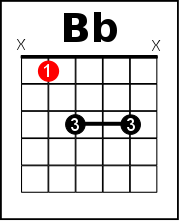

Version 2
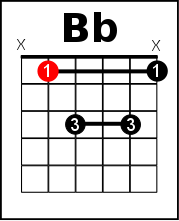

Now, to actually play the ring finger barre like this deserves a lesson on its own but here are some tips. These are useful because the above two variations of the same shape are the most useful and probably most practical way to play the Bb chord.
- Don’t practice this shape on fret 1 (index finger) and fret 3 (ring finger) instead, start higher up the fretboard (fret 5 and 7 are a good place for most) and then work your way down one fret at a time. This is standard practice in my teaching and a lot of you know this already.
- Put the ring finger on first. Yes, DO NOT place the index on first, it makes far more sense to first put the weaker ring finger on which is doing a lot more work than the stronger more independent index finger.
- Get the ring finger close to the fret and pluck each of the D, G, and B strings individually to ensure they are clear.
- Then, when the above notes are clear, slowly add the index on to the first fret of the A string.
- Also, take lots of breaks, and remember my barre chord rule, technique always trumps pressure.
Below are the same two shapes but using individual fingers instead of the ring finger doing the work of the barre.
I’m not as keen on this way but I know a few students like this better.
Version 3
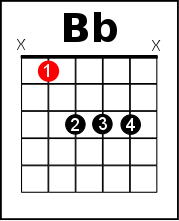

Version 4


This can be hard to get into and your chord changes can be slow when playing this way. You may also struggle with getting a clear sound on each string with this shape, particularly higher up the fretboard where the frets get close together.
It takes a lot of precision to cram three fingers into one fret on adjacent strings – even more so up at fret 5 and upwards for most.
By all means, try this way and stick with it if it works for you. Guitar playing is not a one size fits all solution but if you have tried this way and struggled, try switching to the first method
Keep in mind, the first method (versions 1 and 2) require more practice and better technique but can be far easier to change in and out of quickly once you can play it.
The E shape version
Now we have the E shape version of the chord. One with the big full barre which is good when you need the B and high E strings to be clear and one where we use the index finger to mute these strings.
Version 1
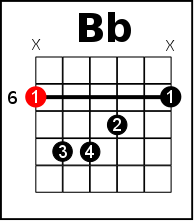

Version 2
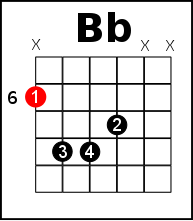

The second version can be very useful when strumming as it gives us all the bass we need but means we are actually doing NO barring at all.
Instead, to play the second version, simply fret the four notes as shown above (version 2), get them clear, and then rest the lower part of your index finger across the strings so it lightly touches the B and high E string.
To the naked eye, this version can make it look like you are barring but you are not.
It’s not an easy skill but the ability to purposely mute strings like this is a good one to develop as there will be times you will want to use this shape (e.g. often if a song uses all barre chords, you will want to save your energy or if there are lots of fast changes in and out of this shape).
Some useful ways to play the B chord
Now that we have looked at the main and most useful ways to play the Bb chord on guitar, I want to give you some useful ways you might not have thought about before.
Power Chord Bb
Yep, this one is for any rockers out there and is simply a power chord. This can be substituted for a full Bb chord at any point as a power chord is essentially a barre chord minus a few notes. It will not sound as full but often will do the job – especially when rocking out with an overdriven electric!
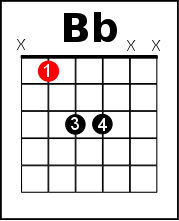

Power Chord with added 3rd
This is a bit like the power chord version above but instead, we lighten the sound a little by adding the 3rd note of the chord on the B string. This gives us more of an acoustic sound and can be useful in some situations. It’s a bit like an earlier A shape version but without the cramming of the fingers in a small space!
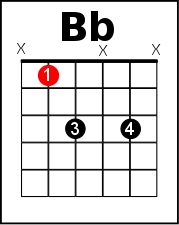

Jangly Triad
Here, we have a very light sounding Bb that will work if you are accompanying another guitarist and picking out the notes. If they are playing acoustic, you could try this one with an electric with some reverb and get a little triad picking pattern going. Doing this reminds me of some cool stuff by The Smiths or The Byrds.


Inversions
Inversions are great and can sound real sweet when used well. They are generally used more in a band setting but if you like to jam along to backing tracks, you can use them here too.
An inversion basically means to make the bass note or lowest note in the chord any note other than the root note.
For example, the root note for a Bb chord is the note of Bb and this is usually the lowest note in the chord.
A Bb chord also contains the notes of F and D and if we decide to make the F note or the D note the lowest in the chord, we have just made the chord an “inversion”.
Chord inversions often sound subtly sophisticated.
Have a look at these three B flat inversions below and see if you can spot which of the notes of Bb, D or F is the new bass note for each?
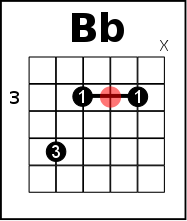

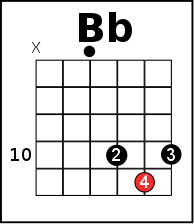

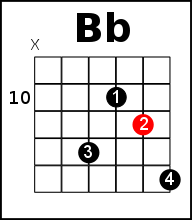

Beware of these fairly commonly taught ways to play the Bb flat major chord on guitar
The following are a bunch of ways that I have seen taught over the years and a quick Google search will show lots of images similar to the following.
I pretty much hate these ways of playing the Bb chord on guitar.
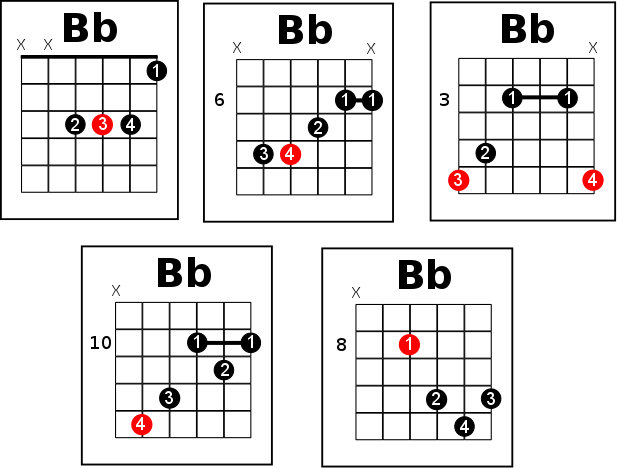

- Top left – A really difficult version of the A shape which creates a lot of tension for most guitarists when trying to play (me included). Generally, you are much better off going for one of the other A shapes than this. For me this is awful!
- Top middle – A more awkward version of the E shape. Unless you really need the high E string note, I would avoid this way and play one of the earlier E shapes instead.
- Top right – Can you see how this is based on the G chord shape? Either way, it is brutal trying to play this. The first inversion shown is actually a much simpler and easier to play stripped back version of this.
- Bottom left – Another nasty way of playing this which is based on the C Major chord shape. Not very easy at all!
- Bottom right – Based on the D chord, this one is a tough way of playing Bb too. I would go with one of the A or E shapes instead.
The useful theory of the Bb barre chord in a nutshell
Now that we have gone into detail on how to play this chord, it’s time to find out exactly where you can use the chord, in what songs and a little bit of the useful theory behind why it is so important.
Why bother learning this chord, you might think?
I mean, how often do you play songs in B flat?
Well, apart from Johnny B. Goode which is in Bb (but geek alert, in Back to the Future, Marty McFly says it is in the key of B even though he plays in B flat. (Bad filmmakers not picking up on this, yes this is geeky knowledge of mine I know!)
Anyway, I digress, there aren’t really many songs that you will play that are in the key of B flat (apart from Johnny B. Goode), but there are some common keys that like to use the B flat chord.
For example, a big one is the key of C Major.
Now, the B flat major chord is NOT in this key as I talk about in my music theory for guitarists book, but one of the common “outside” chords is the Bb chord.
Why is this? Well, let’s have a little deeper look at the key of C.
These are the chords in this key.
- C
- Dm
- Em
- F
- G
- Am
- B diminished
All are standard chords except for, yep, the dog turd sounding B diminished (not really, I quite like the chord, especially when it’s a diminished 7, but it takes some skill to use well).
Most songwriters are great at their art but apart from jazz, classical and some blues guitarists, many don’t know how to use this diminished chord.
They, therefore, often “flatten” it (move it down one fret) and turn it into a Major chord, and what does that leave us with?
A B flat
You will see this crop up in some songs.
You will also see the Bb chord in some songs in the keys of F, G, and even D too.
Basically, at various points, all the more popular keys on guitar – C G D and F have the B flat chord as a useful extra to liven things up and add interest and/or pleasant tension.
The B flat chord really is a useful and flexible chord to add to your arsenal of chords.
Here is a list of classic and not so classic songs (cough, Nickleback, kidding, the whole Nickleback hatred thing is boring now and this is a pretty decent pop tune) have a dreaded B flat in it at various points.
- Prince/Sinead O’Connor – Nothing Compares 2 U
- Queen – Crazy Little Thing Called Love
- David Bowie – Space Oddity
- The Commodores/ Faith No More – Easy
- Nirvana – Pennyroyal Tea
- Nickleback – Rockstar
- The Script – Breakeven
- Pink Floyd – Shine on You Crazy Diamond
- Dire Straits – Sultans of Swing
There are obviously a lot more songs than the above but these give you an idea how much this chord can crop up.
Note, you can play some of the above songs without a Bb Major chord by using the chords from a different key with a capo (but doing so doesn’t always sound good though).
Going much deeper – The CAGED system relating to the B flat chord
For anyone looking to get a bit deeper into understanding the guitar, music theory and the fretboard, and how they relate, it’s a good idea to see the parent chords of all of the above shapes.
All of the above chord shapes (and in essence, every chord you learn is the same) are derived from these five parent chords in some form, some obvious and some not so obvious.
These are the chords of C A G E D and this is where the “Caged system” comes from. (I’ll write more on this in future posts if you want).
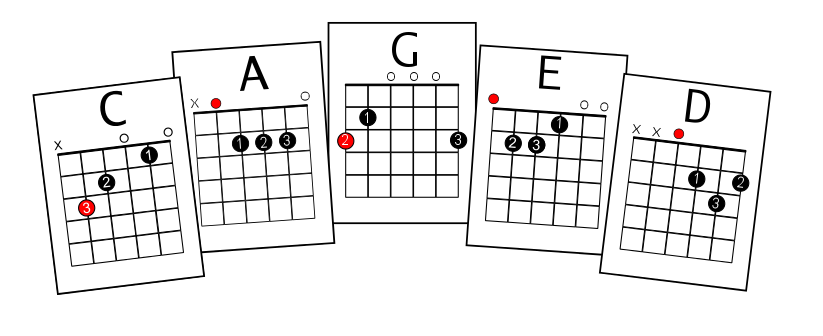

Seeing how these chords all relate will help you understand what is happening on a deeper level which can clear things up down the line rather than everything seeming random. Being a real student of the guitar is definitely a good thing.
Here’s something to think about.
- How did I work out all of the above chord shapes in this post?
- Did I remember them? NO
- I did so simply by learning the fretboard and applying the shapes I already knew and then omitting notes and moving fingers about where needed to get the notes to make up the chord.
- I had to apply music theory, fretboard knowledge and a keen sense of inquisitiveness to get to this point.
- I didn’t wake up one day with this ability, (that would have been nice!) but I studied how some people got different shapes such as F and how they related to the other shapes all using the CAGED chords.
It takes time but working out what is happening when you play any barre, partial or unusual chord shape and relating it back to the parent chord is something I recommend you do (once you get the basics sorted with your playing).
If you do so, you won’t just be able to work out the Bb chord on guitar, on any area of the fretboard but you will be able to work out any chord you like anywhere you like.
That is pretty liberating.
Go back over all the shapes in this post and see if you can write down which one of the shapes is the “parent” chord for that way of playing Bb.
If you get stuck, leave a comment below, and let me know, I’ll answer. This isn’t easy, but it is fun and liberating.
Most of all, choose the best method for playing Bb from above, follow the advice on playing it and add it to your repertoire so you don’t get stuck the next time a song uses this deadly chord!
MY NEWS IN YOUR INBOX
NEWSLETTER SIGNUP
Fix Your Bad Habits, Elevate Your Technique, And Learn Three Stunning Songs With My Two Free And Exclusive eBooks.
[Not Available Anywhere Else]

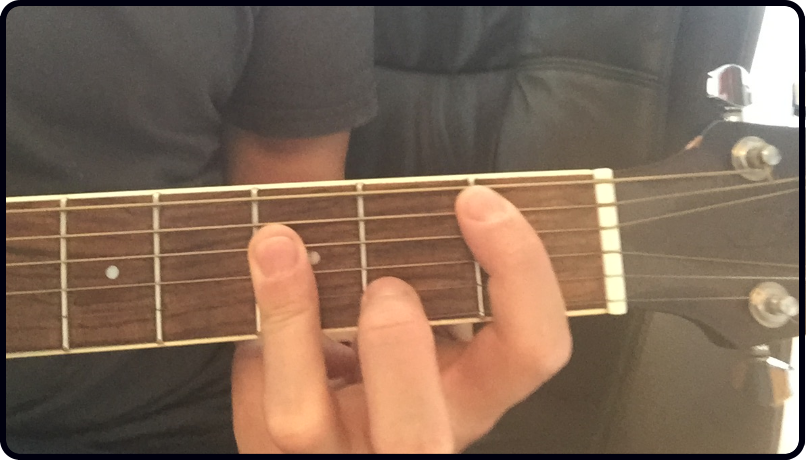

[…] back I showed you multiple ways to play the tricky B minor chord on guitar and more recently the B flat chord on guitar which is also a challenging chord to play. The chord of F is a more common chord as it is in the […]
I am just starting to try something harder than three chord songs, first time I have seen a Bb chord .thank you for this
businesses
Bb Chord On Guitar – Learn The 12 Ways On How To Play It
Thank you very much for sharing your alternative pickings for the B Flat chord. I’ve been practicing hard to master Barre chords. It takes plenty of practice building muscle memory. It does bring you to the next level of playing. I enjoy it when it sounds right.